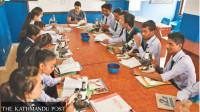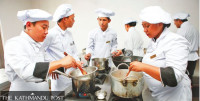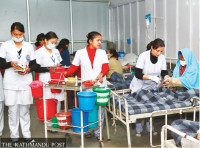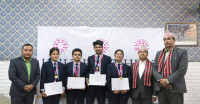Miscellaneous
Peeling away the layers
The nature of identity is twofold: First is physical identity—the tangible things that everyone can see and feel, comprised essentially of the people and physical structures. The second type of identity is the metaphysical identity of a place which is far more elusive and harder to define. It does not involve the superficial aspects of society and one has to dig beneath the surface to find it—it exists in the festivals, everyday rituals, and most of all, in the art and the music that people make.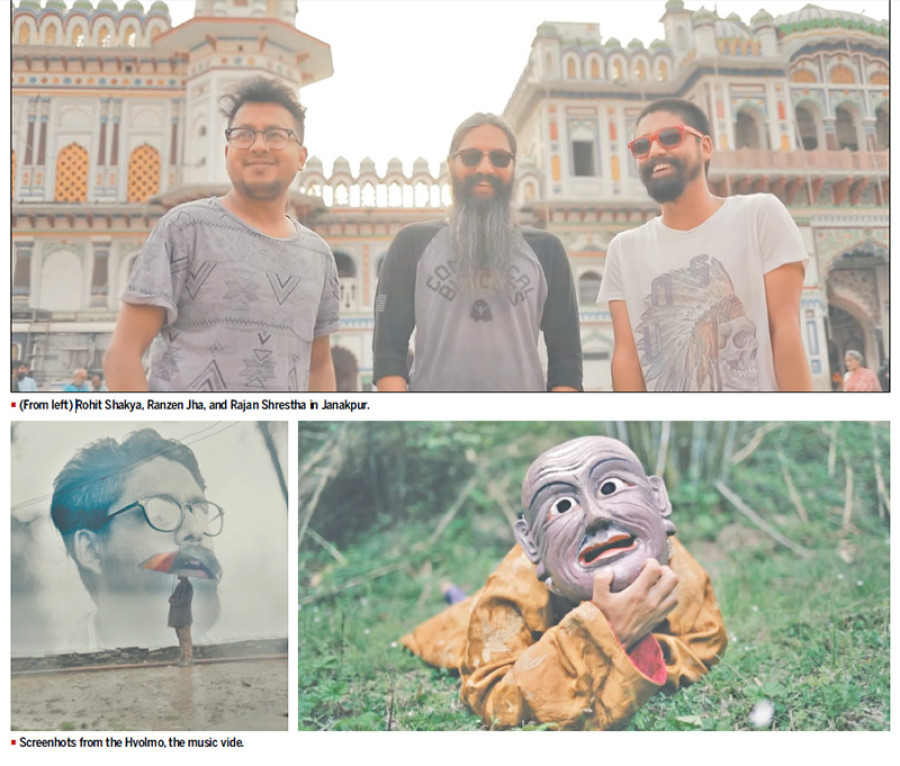
Timothy Aryal
The nature of identity is twofold: First is physical identity—the tangible things that everyone can see and feel, comprised essentially of the people and physical structures. The second type of identity is the metaphysical identity of a place which is far more elusive and harder to define. It does not involve the superficial aspects of society and one has to dig beneath the surface to find it—it exists in the festivals, everyday rituals, and most of all, in the art and the music that people make.
Arguably, it is this second type of identity that gives us a true sense of life—you cannot truly understand a place and its people in the capacity of a tourist because to really understand it, you must live it. However, even a short sojourn can give us a taste of the truth especially if one is open to new experiences. And in doing so, people often find that the customs and ways of life and music, especially music, of disparate people are not so different from their own. So it is this more metaphysical appreciation of life that is so crucial as it is what binds us together as human beings.
Art is a reflection of life; George Eliot had called it the nearest thing to life—essentially, an analogy—but let us not delve into the philosophics of it—that would be tedious and this should be entertaining, no? An interesting documentary series called Fuzzscape, brainchild of the Kathmandu-based audio-visual group Fuzz Factory Productions, is dedicated to uncovering the truth of life and identity in various places across the country by delving into the musical traditions of the people they visit. The metaphysical understanding of identity is favoured by the series as it follows a group of artists who travel to towns, cities and villages and document their experiences along the way while they engage with local artists and even collaborate on some music.
The first episode, Kapase Badal, was released via Youtube in March, 2016, and the idea was to “[move] into a new space to collaborate, get influenced and to inspire… to create a body of work, which is an outcome of [the artists’] experiences together in the given space,” say the producers of the show. For the first episode, the artists “indulge in three days of good food, nature and each other’s company to create a musical piece.”
Kapase Badal starts, like all other episodes in the series so far, with an introduction of the artists along with a brief of the work they aspire to do, which is usually to seek inspiration from the surroundings and sample the soundscape of the places and incorporate it into a song. For this episode, three artists working with audio-visual mediums—Rajan Shrestha, Rohit Shakya and Ashesh Rai—travel to Banepa, make a makeshift studio in their hotel room and work on their craft, in the same way a Foley artist goes about her work, incorporating culled sounds from different sources into a cohesive piece. The documentary is frankly narrated and gives the audience an intimate glimpse to the way they work. The songs produced are often an amalgam of natural sounds and electric music. The songs are easy on the ears and the videos make you want to visit those places yourself.
The second episode starts off with a Marcel Proust quote—“The real voyage of discovery consists not in seeking new lands but seeing with new eyes”—and follows the Kathmandu-based musicians to Sermathang in Helambu. The quote is a little ironic maybe given the series is dedicated to people travelling to new places but I am sure, the point about “seeing with new eyes” is not lost on the people participating in the show. In this second episode, the musicians go on to interact with local residents and collaborate on a song called, Hyolmo.
What started as a journey to seek inspiration to make music, compounds in the third episode, Jhijhiya, which is by far the best episode in the series, as one more dedicated to the culture, politics, and history that define the places they visit. Prior to this, the show had been about making music at a given place and showcasing the process. The third episode follows the artists to the border city of Birgunj where they interact with local musicians while also giving us a glimpse of the changing socio-economic scenario of the city. “For centuries, people were compelled to cross the border to India for work. The destination may have changed but not the reality,” the narrator says.
The fourth episode takes place in Bhojpur where the artists collaborate with Barta Gandharva, a sarangi player eking out a living solely by playing in the streets—she is something of a revelation. The fifth and latest episode, Janakpur, follows a similar pattern as the musicians collaborate with local singer Shivani Bhagat.
All the episodes in the series have a similar structure. The videos start with an introduction, then document the tour and the artists’ interactions with the local community and wrap up with a song that was created along the course of the episode.
That Nepal has a diverse culture and musical tradition goes without saying. At the same time, with so many youths leaving home for work abroad, the tradition once practiced is now on the wane. With that said, the growing diaspora must have also played a considerable part in spreading Nepali music across the world and these things are yet to be accounted for. Documentaries like Fuzzscape give us a short but clear view of the places they visit, evincing at least some of its contradictions and beauty, and as such, the show provides much needed exposure to the rest of the country for urbanised and insulated city dwellers. The music that Fuzzscape produces mixes folk tunes with digitally produced sound, which is definitely one way to conserve and revive fading musical traditions (one of the show’s stated goals); however it is probably neither the best nor a reliable way of doing so—what it is, is a start—and a very good one at that.




 17.12°C Kathmandu
17.12°C Kathmandu


